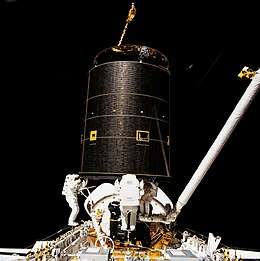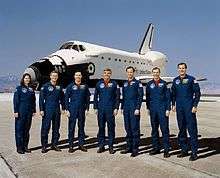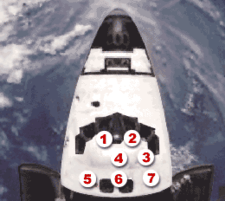STS-49
STS-49 was the maiden flight of the Space Shuttle Endeavour, which launched on May 7, 1992. The primary goal of its nine-day mission was to retrieve an Intelsat VI satellite (Intelsat 603, which failed to leave low earth orbit two years before), attach it to a new upper stage, and relaunch it to its intended geosynchronous orbit. After several attempts, the capture was completed with the only three-person extra-vehicular activity (EVA) in space flight history.[1] It would also stand until STS-102 in 2001 as the longest EVA ever undertaken.
 Hieb, Akers, and Thuot assist in capturing the Intelsat 603 satellite from its derelict orbit | |
| Mission type | Satellite repair |
|---|---|
| Operator | NASA |
| COSPAR ID | 1992-026A |
| SATCAT no. | 21963 |
| Mission duration | 8 days, 21 hours, 17 minutes, 38 seconds |
| Distance travelled | 5,948,166 kilometers (3,696,019 mi) |
| Orbits completed | 141 |
| Spacecraft properties | |
| Spacecraft | Space Shuttle Endeavour |
| Landing mass | 91,214 kilograms (201,092 lb) |
| Payload mass | 14,618 kilograms (32,227 lb) |
| Crew | |
| Crew size | 7 |
| Members |
|
| Start of mission | |
| Launch date | 7 May 1992, 23:40:00 UTC |
| Launch site | Kennedy LC-39B |
| End of mission | |
| Landing date | 16 May 1992, 22:57:38 UTC |
| Landing site | Edwards Runway 22 |
| Orbital parameters | |
| Reference system | Geocentric |
| Regime | Low Earth |
| Perigee altitude | 268 kilometres (167 mi) |
| Apogee altitude | 341 kilometres (212 mi) |
| Inclination | 28.35 degrees |
| Period | 90.6 min |
  Left to right: Thornton, Melnick, Thuot, Brandenstein, Chilton, Akers, Hieb | |
Crew
| Position | Astronaut | |
|---|---|---|
| Commander | Daniel C. Brandenstein Fourth and last spaceflight | |
| Pilot | Kevin P. Chilton First spaceflight | |
| Mission Specialist 1 | Richard J. Hieb Second spaceflight | |
| Mission Specialist 2 | Bruce E. Melnick Second and last spaceflight | |
| Mission Specialist 3 | Pierre J. Thuot Second spaceflight | |
| Mission Specialist 4 | Kathryn C. Thornton Second spaceflight | |
| Mission Specialist 5 | Thomas D. Akers Second spaceflight | |
Spacewalks
- Thuot and Hieb – EVA 1
- EVA 1 Start: 10 May 1992 – 20:40 UTC
- EVA 1 End: 11 May 1992 – 00:23 UTC
- Duration: 3 hours, 43 minutes
- Thuot and Hieb – EVA 2
- EVA 2 Start: 11 May 1992 – 21:05 UTC
- EVA 2 End: 12 May 1992 – 02:35 UTC
- Duration: 5 hours, 30 minutes
- Thuot, Hieb and Akers – EVA 3
- EVA 3 Start: 13 May 1992 – 21:17 UTC
- EVA 3 End: 14 May 1992 – 05:46 UTC
- Duration: 8 hours, 29 minutes
- Thornton and Akers – EVA 4
- EVA 4 Start: 14 May 1992 – ~21:00 UTC
- EVA 4 End: 15 May 1992 - ~05:00 UTC
- Duration: 7 hours, 44 minutes
Crew seating arrangements
| Seat[2] | Launch | Landing |  Seats 1–4 are on the Flight Deck. Seats 5–7 are on the Middeck. |
|---|---|---|---|
| S1 | Brandenstein | Brandenstein | |
| S2 | Chilton | Chilton | |
| S3 | Hieb | Thuot | |
| S4 | Melnick | Melnick | |
| S5 | Thuot | Hieb | |
| S6 | Thornton | Thornton | |
| S7 | Akers | Akers | |
Mission highlights
The Intelsat 603 satellite, stranded in an unusable orbit since launch aboard a Commercial Titan III rocket in March 1990, was captured by crewmembers during an EVA (extra-vehicular activity) and equipped with a new perigee kick motor. The satellite was subsequently released into orbit and the new motor fired to put the spacecraft into a geosynchronous orbit for operational use.
The capture required three EVAs: a planned one by astronaut Thuot and Hieb who were unable to attach a capture bar to the satellite from a position on the RMS; a second unscheduled but identical attempt the following day; and finally an unscheduled but successful hand capture by Thuot, Hieb and Akers as commander Brandenstein delicately maneuvered the orbiter to within a few feet of the 4215 kg communications satellite. An Assembly of Station by EVA Methods (ASEM) structure was erected in the cargo bay by the crew to serve as a platform to aid in the hand capture and subsequent attachment of the capture bar.
A planned EVA also was performed by astronauts Thornton and Akers as part of the ASEM experiment to demonstrate and verify maintenance and assembly capabilities for Space Station Freedom. The ASEM space walk, originally scheduled for two successive days, was cut to one day because of the lengthy Intelsat retrieval operation.
Other "payloads of opportunity" experiments conducted included: Commercial Protein Crystal Growth (CPCG), Ultraviolet Plume Imager (UVPI) and the Air Force Maui Optical Station (AMOS) investigation. The mission was extended by two days in order to complete all the mission objectives.
The following records were set during the STS-49 mission:[3]
- First flight of the shuttle Endeavour
- First EVA involving three astronauts.
- Second and fourth longest EVAs to date: 8 hours and 29 minutes and 7 hours and 45 minutes. (Longest EVA to date was during STS-102 in 2001: 8 hours 56 minutes; third longest EVA was during STS-61 in 1993: 7 hour 54 minutes)
- First Shuttle mission to feature four EVAs.
- The second longest EVA time for a single Shuttle mission: 25 hours and 27 minutes, or 59:23 person hours. (The longest is STS-61 with 35 hours and 28 minutes)
- First Shuttle mission requiring three rendezvous with an orbiting spacecraft.
- First use of a drag chute during a Shuttle landing.
Wake-up Calls
NASA began a tradition of playing music to astronauts during the Gemini program, and first used music to wake up a flight crew during Apollo 15. A special musical track is chosen for each day in space, often by the astronauts' families, to have a special meaning to an individual member of the crew, or in reference to the day's planned activities.
| Day | Song | Artist/Composer | Played For |
|---|---|---|---|
| Day 2 | "God Bless the U.S.A." | Lee Greenwood | |
| Day 3 | "Rescue Me" | Fontella Bass | |
| Day 4 | "Theme from Winnie the Pooh" | Kathy Thornton (from her Children on Mother's Day) | |
| Day 5 | "Gonna Fly Now (Theme from Rocky)" | Bill Conti | |
| Day 6 | "Kokomo" | The Beach Boys | |
| Day 7 | No song | ||
| Day 8 | "I wake up with a smile on my face" | Boxcar Willie | |
| Day 9 | "Son of a Son of a Sailor" | Jimmy Buffett |
Gallery
 Thuot during one of the capture attempts
Thuot during one of the capture attempts Re-deployment of Intelsat 603
Re-deployment of Intelsat 603 ASEM is manipulated by the RMS; Thornton and Akers during EVA 4
ASEM is manipulated by the RMS; Thornton and Akers during EVA 4
See also
References
![]()
- Facts about spacesuits and spacewalks (NASA.gov) Archived 3 June 2013 at the Wayback Machine
- "STS-49". Spacefacts. Retrieved 4 March 2014.
- NASA (2001). "STS-49". National Aeronautics and Space Administration. Retrieved 7 December 2007.
.jpg)